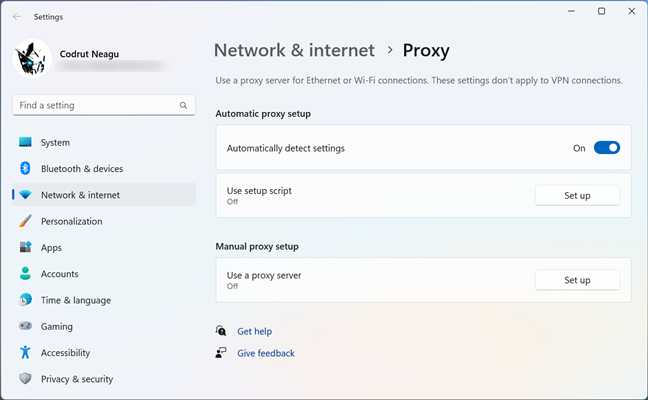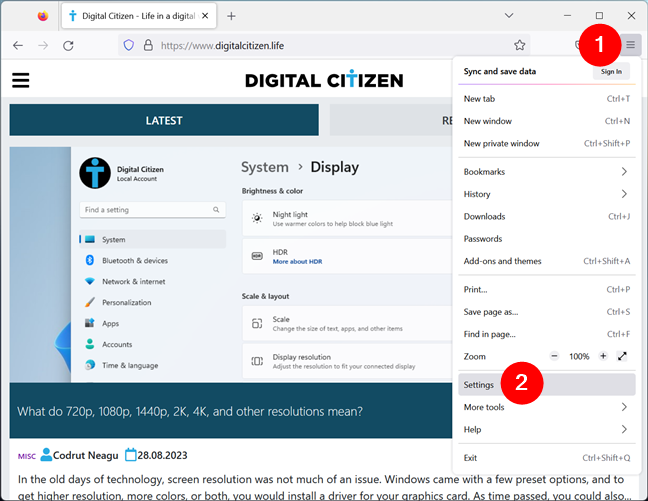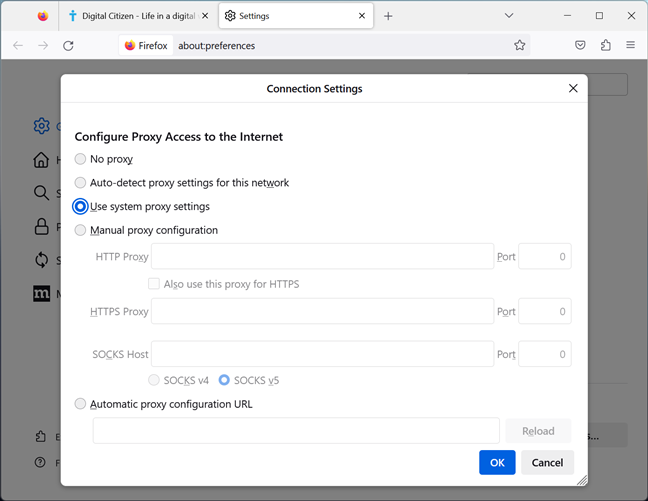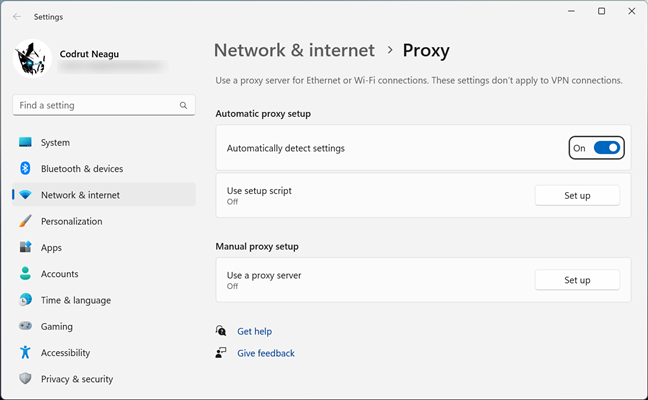
Proxy servers are intermediaries between your PC and the internet. When your browser uses a proxy server, the websites you access see the proxy as the actual visitor instead of your computer. This can improve your online privacy and security while also helping you bypass content restrictions on the internet. Enterprises also use proxies in order to monitor, filter, and secure what their employees browse on the internet, in an effort to ensure that the accessed content respects the company’s policies. Read this tutorial to find out how to change Chrome’s proxy settings and configure a proxy in Firefox, as well as the steps to set up a proxy for Edge, Opera, and Opera GX in Windows. Let’s get started:
NOTE: If you don’t know what a proxy server is and why you may want to use one, you should first read this article: What is a proxy server? What are its benefits & drawbacks?. Then, depending on what browser you’re using, skip to the chapter below that applies to it.
How to change Chrome’s proxy settings
Chrome does not offer any unique configuration options for setting a proxy server because it uses the same proxy settings as Windows 11 or Windows 10. To change Google Chrome’s proxy settings, first, click or tap on the “Customize and control Google Chrome” button from the browser’s top-right corner. Its icon looks like three vertical dots. Then, click or tap on Settings.

Access Chrome's Settings
In the left sidebar, select System, and click or tap the “Open your computer’s proxy settings” link on the right.

Open your computer's proxy settings to set a proxy for Chrome
This opens Windows’ proxy settings page from the Settings app. Here, regardless of whether you’re using Windows 11 or Windows 10, you get the same options to automatically configure the proxy settings with a script address or use a manually selected proxy server. However, things look a bit differently in the two operating systems, so here’s what you should expect to see in Windows 11 versus Windows 10:
How to set a web browser proxy server in Windows 11
In Windows 11, the Proxy page from the Settings app contains all the options available for configuring and changing the browser proxy server. What you’ll see should be similar to the screenshot following this paragraph. If you need help setting a proxy on your Windows 11 computer, I recommend reading this in-depth guide: How to set the proxy settings in Windows 11.

The Proxy server settings in Windows 11
However, if you don’t have the time to read our dedicated tutorial, this is the brief version of what you need to do in order to manually set up a browser proxy server in Windows 11:
First, click or tap the Set up button next to the “Use a proxy server” option.

Configure Windows 11's proxy server settings
Then, in the Edit proxy server dialog that shows up, make the following changes:
- Turn the “Use a proxy server” switch On.
- Type the address of the proxy server and the port to use.
- Click or tap on Save to apply your settings.

Chrome uses the proxy settings from Windows 11
And that’s it! From now on, Google Chrome will connect to the internet using the browser proxy server you’ve set in Windows 11.
How to set a web browser proxy server in Windows 10
In Windows 10, the Settings app lists all the options for setting the browser proxy server on one page, like in the next screenshot. If you need guidance on adjusting all these settings, we’ve covered them in detail in this dedicated tutorial: How to configure proxy server settings in Windows 10.

Configure Windows 10's proxy server settings
If you don’t feel like reading our dedicated tutorial, here’s a summary of the instructions for manually setting up a proxy in Windows 10:
- Enable the switch under “Use a proxy server.”
- Enter the address for the proxy server and the port you want to use.
- Press Save to apply your settings.

Chrome uses the proxy settings from Windows 10
TIP: If you’re concerned about online privacy, a VPN is another way to go. Find out when to use a proxy server and when to use a VPN.
How to set a proxy in Firefox
If you want your browser to use a different proxy server than the default one set in your Windows 11 or Windows 10 operating system, Mozilla Firefox is a great option. You can easily change the Firefox proxy settings to route the web browser traffic through a proxy. To begin, click or tap on the hamburger button in the browser’s top-right corner and then on Settings.

Access the Firefox Settings
This takes you to the General settings. Scroll down to the bottom of this tab to the Network Settings section. Then, click or tap on the Settings button.

Access Settings to configure how Firefox connects to the internet
In the Connection Settings pop-up, you can find the proxy-related options. By default, Firefox is set to “Use system proxy settings,” meaning that it uses the proxy server settings of your Windows 11 or Windows 10 computer. However, there are other alternatives.

Firefox's default is to Use system proxy settings
To configure a separate browser proxy server for Firefox, one option is to select “Manual proxy configuration” and enter the proxy details. Unlike other browsers, Firefox allows you to set different proxy servers and ports for various kinds of internet protocols such as HTTP, HTTPS, and SOCKS.

Manually configure the Firefox proxy
You can also select the “Automatic proxy configuration URL” option and then insert the address to your PAC file. In this case, Firefox downloads a file with all the required information to use the configured proxy server.

Select Automatic proxy configuration URL to set up a Firefox proxy
If you don’t want to use a proxy server for certain addresses, you can add them separated by a comma (,) in the “No proxy for” text box. To save your settings, click or tap on OK.
How to change proxy settings in Microsoft Edge
Microsoft Edge uses the Windows proxy settings, just like Google Chrome. To change them, start Microsoft Edge, click or tap on the “Settings and more” (...) button in the top-right corner, and access Settings.

Access the Microsoft Edge Settings
Select System and performance in the left sidebar, and then, on the right, click or tap on “Open your computer’s proxy settings.”

Open your computer's proxy settings to set an Edge proxy
This opens the Proxy page from the Settings app on your Windows 11 or Windows 10 computer, where you can set up the connection with a script address or use a manually selected proxy server. For more details, as well as instructions for each of these two options, read the two sub-chapters in the first section of this guide: the same steps apply for both Chrome and Edge.

Configure the proxy server settings in Windows 11
TIP: You can also set an Android proxy server for Wi-Fi on your smartphone or tablet.
How to set a proxy in Opera or Opera GX
If you’re using Opera or Opera GX, its proxy settings are the ones you configured in Windows 11 or Windows 10, just like Chrome’s and Edge’s. Click or tap the Menu button in the top-left corner and select Settings in the menu.

Access Opera's Settings
Scroll down the list of Settings until you reach the bottom. Then, click or tap on Advanced.

Go to Opera's Advanced settings
In the Advanced settings, scroll down to System, and then click or tap “Open your computer’s proxy settings” link.

Open the Windows proxy settings
This takes you to the proxy settings page from the Settings app. Here, you can configure them using a script address or a manually selected proxy server. If you need help with them, read the two sub-chapters for Windows 11 and Windows 10 from the first section of this guide.

Configure the browser proxy server settings in Windows
TIP: Did you know you can also use a proxy server for Wi-Fi on an iPhone?
Why did you set up a browser proxy server?
Now you know how to set up a proxy server for all major browsers. Before you close this guide, I’d like to know your reasons for using a proxy. Do you worry about your privacy, or are you trying to access restricted content on hub sites filled with hamsters? 🙂 Or maybe your reasons are more mundane, and you don’t really have a choice, as your network administrator mandates using the company’s proxy server? Whatever the case, let me know in the comments. Also, if you’d like us to keep you updated with all our latest tutorials, don’t hesitate to subscribe to our newsletter.


 31.08.2023
31.08.2023 


